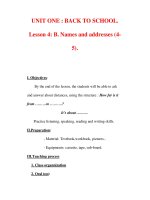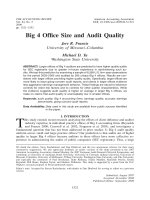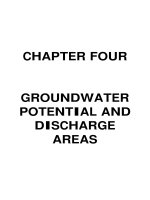4 9 landforms and waterways
Bạn đang xem bản rút gọn của tài liệu. Xem và tải ngay bản đầy đủ của tài liệu tại đây (3.12 MB, 10 trang )
Fascinating Facts
• American writer Mark Twain described the shape
of the Mississippi River as “a long, pliant [easily
bent] apple-paring [peeling].”
• Each of the Great Lakes ranks among the fourteen
largest lakes in the world.
• Rain forests grow in parts of the West near the
Pacific coast.
LANDFORMS
Genre
Nonfiction
Comprehension Skill
Compare and
Contrast
Text Features
• Maps
• Captions
AND
WATERWAYS
Scott Foresman Social Studies
ISBN 0-328-14842-3
ì<(sk$m)=beiece< +^-Ä-U-Ä-U
by Ann Rossi
Many natural features contribute to the
distinctive quality of the different areas of the
United States. In this book you will read about
some of the natural features found in the diverse
areas of our country.
Write to It!
Think about the landforms and waterways you
just read about. Make a chart to show in which
regions they are located. Choose one region and
write two or three paragraphs describing some of
the things you could see if you visited that region.
Vocabulary
region
desert
landform
mountain
erosion
volcano
plain
wetland
prairie
waterway
glacier
Write your paragraphs on a separate sheet of paper.
LANDFORMS
AND
WATERWAYS
Maps
MapQuest, Inc.
Photographs
by Ann Rossi
Every effort has been made to secure permission and provide appropriate credit for photographic material. The publisher deeply
regrets any omission and pledges to correct errors called to its attention in subsequent editions.
Unless otherwise acknowledged, all photographs are the property of Scott Foresman, a division of Pearson Education.
ISBN: 0-328-14842-3
Photo locators denoted as follows: Top (T), Center (C), Bottom (B), Left (L), Right (R), Background (Bkgd)
Copyright © Pearson Education, Inc.
All Rights Reserved. Printed in the United States of America. This publication is protected
by Copyright, and permission should be obtained from the publisher prior to any prohibited
reproduction, storage in a retrieval system, or transmission in any form by any means,
electronic, mechanical, photocopying, recording, or likewise. For information regarding
permission(s), write to: Permissions Department, Scott Foresman, 1900 East Lake Avenue,
Glenview, Illinois 60025.
Opener: ©Digital Vision
2 ©David Edwards/NGS Image Collection
6 (T) ©Corbis, (CL) ©DK Images
7 ©Transparencies, Inc. Editorial Offices: Glenview, Illinois • Parsippany, New Jersey • New York, New York
9 ©Jake Rajs/Getty Images
10 ©Digital Vision
Sales Offices: Needham, Massachusetts • Duluth, Georgia • Glenview, Illinois
13 ©NASA/Corbis
Coppell, Texas • Sacramento, California • Mesa, Arizona
14 ©Getty Images
15 ©Iain Davidson Photographic/Alamy
1 2 3 4 5 6 7 8 9 10 V0G1 14 13 12 11 10 09 08 07 06 05
Regions of the United States
Regions of the United States
CA
100 Miles
IL
KS
MO
OK
Re d R .
AR
TX
IN
Oh
i
0
0
N
MEXICO
200
DC
VA
NC
P
AP
SC
GA
L
AL
AT
TN
MS
OH
R . WV
KY
LA
PACIFIC
OCEAN
HI
AN
T
MO
PL IC C
UN
A I OA
TA
N
ST A
INS
L
CO
Colo
R. ra
COLORADO
PLATEAU
do
AZ
NM
PA
IA
AC
NS
0
CA
TAI
PACIFIC OCEAN
HI
UT
NE
MA
NY
MI
WI
SD
WY
ME
RI
CT
NJ
DE
MD
AN
UN
Northeast
Southeast
Midwest
Southwest
West
NV
MN
o
MO
ID
PACIFIC OCEAN
Key
NH
VT
AL
OR
MT M issouri R ND
.
Y
400 Kilometers
CK
0
WA
RO
400 Miles
R.
D
0
0 100 Kilometers
Dramatic rock formations such as this are common in many
parts of the Southwest.
CANADA
A
M ississip
pi
AK
NA
A variety of diverse areas make up the United
States. Some people divide the United States into
regions that include the Northeast, Southeast,
Midwest, Southwest, and West. Each region has
its own qualities and a unique set of characteristics.
Many people often think of the Midwest as having
endless miles of grasses waving in the wind. When
people picture the Southwest, they might visualize
a desert or perhaps a dramatic rock formation.
The combination of natural features in each region
contributes to the unique character of that region.
FL
ATLANTIC
OCEAN
Gulf of
Mexico
400 Miles
200 400 Kilometers
This map shows the five regions of the United States.
Despite the distinctive quality of each region, it
may also possess a type of landform that exists in
other regions. For example, nearly every region has a
mountain range. Each of the regions in the United
States has many different kinds of landforms. Some of
them will be examined in this book, as will the forces
that shape the natural features of the United States.
2
3
Steep-sloped Landforms
Mountains are landforms that usually have steep
slopes and sharp or slightly rounded peaks. Scientists
believe that Earth has an outer layer, or shell, made
up of many pieces called plates. These plates float on
a layer of melted rock, which is always moving and
therefore pushes the plates around. Sometimes the
plates bump into each other or are pushed a certain
way, causing a particular kind of mountain to form.
Once the mountain has formed, other natural forces
such as wind, rain, and erosion begin to shape the
mountain.
The Rocky Mountains are the largest mountain
system in North America. Made up of several smaller
mountain ranges, this vast mountain system is
more than 3,000 miles (4,800 kilometers) long and
stretches from New Mexico in the Southwest up to
Alaska in the West, passing through Canada. The
highest mountain peaks in the Rocky Mountains are
in Colorado, where numerous peaks are more than
14,000 feet (4,267 meters) high.
Another mountain system in the West is the Pacific
mountain system, which runs parallel to the Pacific
coasts in California, Oregon, and Washington, for
thousands of miles. The Cascade Range is one part
of the Pacific mountain system. The Sierra Nevada,
located in eastern California, is part of the Cascades.
Most of the peaks that are part of the Cascade
Range are volcanoes. Many are dormant, or have not
erupted for a long time. Mount St. Helens, however,
is a volcano that erupted violently in 1980 after being
dormant for more than 120 years. After a period of
activity, the volcano again went to sleep. Then in
October 2004, Mount St. Helens erupted again.
Another part of the West that has active volcanoes is
Hawaii, which is made up of 132 islands, all of them
formed by volcanoes.
Hawaii Volcanoes National Park
At Hawaii Volcanoes National Park, visitors can view
Kilauea (key-law-WAY-aw), one of Earth’s most active
volcanoes. Kilauea has been erupting fairly steadily
since 1983.
4
5
Mount St. Helens is located in Washington.
Inside a Volcano
Ash cloud
Lava
Like the Rocky Mountains and the Pacific
mountain system, the Appalachian Mountains are
part of a large mountain system in North America.
Unlike those mountain systems, however, the
Appalachians are in the eastern part of the continent,
stretching for about 1,500 miles (2,400 kilometers)
from Alabama in the Southeast up through the
Northeast and into Canada.
Although the Rocky Mountains are the largest
mountain system in North America, the Appalachians
are the oldest. They, too, are made up of several
mountain ranges that include the White Mountains,
the Green Mountains, the Catskills in the Northeast,
and the Black Mountains and the Great Smoky
Mountains in the Southeast. The tallest peak of the
Appalachians measures 6,684 feet high (2,037 meters).
The tallest peak of the Appalachians is Mount Mitchell, located
in the Black Mountains.
Feeder pipe
Magma chamber
A volcano may erupt when magma, or melted rock,
gathers underground in a magma chamber. Pressure from
within Earth forces the magma upward through the feeder
pipe. The volcano then erupts, spewing out lava and clouds
of steam, ash, and gases. Lava is the term for magma that
erupts onto Earth’s surface.
6
7
Different Kinds of Plains
A plain is a large area of flat or fairly flat land.
Plains have different names depending upon their
location or their climate. For example, swamps are
low-lying wet plains.
Plains can be found in several regions of the United
States. The Atlantic Coastal Plain lies along the
East Coast of the United States. In segments of the
Northeast, the Atlantic Coastal Plain is fairly narrow.
It widens in the Southeast and covers much of North
Carolina, South Carolina, Georgia, and Florida.
The Gulf Coastal Plain curves along the Gulf of
Mexico from Florida to southern Texas. Both the Gulf
Coastal Plain and the Atlantic Coastal Plain have
many wetlands, such as swamps and marshes. Rivers
flow from inland areas through the coastal plains to
the ocean, picking up soil and depositing it in the
low-lying plains, making coastal soils more fertile.
Barrier Islands
In parts of the Southeast, barrier islands lie off the shore of
the Atlantic Coastal Plain, protecting the mainland from the
force of the ocean waves. In Florida alone barrier islands
make up more than seven hundred miles of the coastline.
These islands form over time as shifting sands build upon
a sandbar.
8
The Great Plains is a dry grassland in North America that
stretches from Texas and New Mexico north into Canada.
Shorter grasses grow in the western parts of the Great Plains
than in eastern areas.
Another type of plain is the prairie, a fairly flat
plain covered chiefly by tall grasses. Prairies stretch
across the Midwest and south into Texas.
Different grasses grow in different parts of the
rich prairie soil. In the wetter eastern parts of the
prairie, the grasses grow taller than they do in the
drier, western part. They are about three times as tall,
reaching heights of more than 6 feet (1.8 meters).
9
Water and Waterways
The Mississippi River is the largest river in the
United States. From its source in Minnesota, the
Mississippi River snakes its way south, forming the
border between several states in the Midwest and in
the Southeast before reaching the Gulf of Mexico.
Along the way the Missouri and Ohio Rivers feed into
the Mississippi River, making it a mighty river system
that is an important waterway in the United States.
Although the Rio Grande’s source is in Colorado,
it is an important river in the Southwest, running
through New Mexico and forming the border between
Texas and Mexico. Its water is used to irrigate crops in
the dry Southwest.
Another major river in the United States is the
Colorado River. It, too, begins in Colorado. It then
cuts through southern Utah and flows into Arizona,
eventually forming the border between Arizona and
California before flowing across the Mexican border
to the Gulf of California. Like the Rio Grande, the
waters of the Colorado are used to irrigate part of the
dry Southwest, but the Colorado River is also a vital
source of water for southern California.
The Mississippi River is a busy waterway.
10
11
Rivers are one important kind of waterway, and
lakes are another. The Great Lakes are a chain of five
lakes in the northern United States, four of which
form part of the border between the United States
and Canada. Long ago, sheets of moving ice called
glaciers created the Great Lakes.
The lakes are part of a major waterway that
connects the Midwest with other areas. Because the
Great Lakes are connected, a boat could go from
the St. Louis River in Minnesota, through the Great
Lakes, and then continue by other waterways all the
way to the Atlantic Ocean.
The Finger Lakes in New York State almost look like fingers on
a hand if you see them from above.
The Great Lakes
250 Miles
n
125
125
250 Kilometers
CANADA
S
MN
aw
re
nc
e
To
Atl Rive
an
ti
r
0
e Superior
Lak
ea
0
cO
c
ME
L
t.
VT
WI
Lake Michiga
n
Lake
Huron
nt
eO
Lak
MI
NH
ario
NY
CT
Lak
e
Er
Illi
n
Riv ois
er
pp
issi
iss
M
MO
NJ
OH
IN
N
MD
IL
DE
Key
ATLANTIC
OCEAN
WV
National border
State border
VA
i
Ri
ve
KY
r
RI
ie
PA
IA
MA
River
The Great Lakes, rivers, and canals combine to form
a network of waterways.
12
The Finger Lakes
are much smaller than
the Great Lakes, and
unlike the Great Lakes,
the Finger Lakes are
not linked. Long ago
the Finger Lakes were
actually rivers, but sheets
of ice reshaped the
earth, cutting trenches
into the river valleys
and thereby creating the
Finger Lakes.
Bottomless Lakes
Although New Mexico
has few natural lakes, the
Bottomless Lakes are well
known. The greenish-blue
color of the lakes makes
them appear bottomless,
but that is just an illusion.
The Bottomless Lakes
range in depth from
17 feet to 90 feet.
13
The Mojave Desert is part of the North American Desert.
Deserts and More
Deserts, unlike lakes, are dry—yet the Pacific
Ocean once covered the Mojave Desert (moe-HAvee). In parts of the Mojave, sandy soil—a souvenir of
the sandy ocean bottom—and extinct volcanoes adorn
the landscape.
In the United States, deserts are located in the
West and Southwest regions. The Mojave Desert in
southeastern California and parts of Nevada, Arizona,
and Utah is part of a larger desert area called the
North American Desert.
14
Although the Mojave is extremely dry—getting
only 2 to 6 inches (50 to 150 millimeters) of rain
per year—it is not necessarily always hot. Frost is not
uncommon in the winter.
All these landforms and waterways—deserts,
volcanoes, rivers, lakes, mountains, plains, islands, and
wetlands—provide a sample of the extensive natural
features that exist in the varied regions of the United
States. From the mountain peaks, across the prairies,
through the deserts, and down the rivers to the coastal
plains, they are part of what makes the United States
special and unique.
15
Many natural features contribute to the
Glossary
distinctive quality of the different areas of the
United an
States.
this
book
willrain
read about
desert
area In
that
gets
veryyou
little
some of the
in water
the diverse
erosion
the natural
wearingfeatures
away offound
rock by
areas
our country.
andofwind
glacier huge sheets of ice that cover land
Vocabulary
landform a natural
feature of the earth’s surface
region
mountain a very high
landform, often with
desert
steep sides
landform
plain an area of flat
land that often is covered
with grass or trees
mountain
prairie an area where
grasses grow well, but
erosion
trees are rare
volcano
region an area in which places share similar
plain
characteristics
wetland
volcano a mountain
with an opening through
prairie
which ash, gas, and
lava are forced
waterway
waterway a system
of rivers, lakes, and canals
through which ships
travel
glacier
wetland land that is covered with water at times
Write to It!
Think about the landforms and waterways you
just read about. Make a chart to show in which
regions they are located. Choose one region and
write two or three paragraphs describing some of
the things you could see if you visited that region.
Write your paragraphs on a separate sheet of paper.
Maps
MapQuest, Inc.
Photographs
Every effort has been made to secure permission and provide appropriate credit for photographic material. The publisher deeply
regrets any omission and pledges to correct errors called to its attention in subsequent editions.
Unless otherwise acknowledged, all photographs are the property of Scott Foresman, a division of Pearson Education.
ISBN: 0-328-14842-3
Photo locators denoted as follows: Top (T), Center (C), Bottom (B), Left (L), Right (R), Background (Bkgd)
Copyright © Pearson Education, Inc.
All Rights Reserved. Printed in the United States of America. This publication is protected
by Copyright, and permission should be obtained from the publisher prior to any prohibited
reproduction, storage in a retrieval system, or transmission in any form by any means,
electronic, mechanical, photocopying, recording, or likewise. For information regarding
permission(s), write to: Permissions Department, Scott Foresman, 1900 East Lake Avenue,
Glenview, Illinois 60025.
Opener: ©Digital Vision
2 ©David Edwards/NGS Image Collection
6 (T) ©Corbis, (CL) ©DK Images
7 ©Transparencies, Inc.
9 ©Jake Rajs/Getty Images
10 ©Digital Vision
13 ©NASA/Corbis
14 ©Getty Images
15 ©Iain Davidson Photographic/Alamy
1 2 3 4 5 6 7 8 9 10 V0G1 14 13 12 11 10 09 08 07 06 05
16









